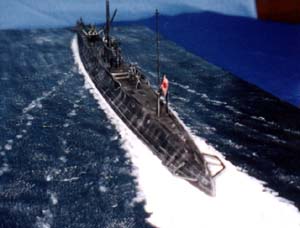 Nichimo
1/200 IJN Submarine I-19
Nichimo
1/200 IJN Submarine I-19
by Richard Eaton
Introduction
I have been yearning to build a large scale submarine for some time. Nichimo has a neat line of subs in 1/200 scale. I love U-boats, but the I-19 has fascinated me for some time. It is kind of equal part submarine, cruiser, and aircraft carrier. I can combine my love of aircraft and nautical themes in one kit! Hello Squadron! Doing some research, I was impressed at the number and capability of Japanese submarines going into WWII. Read on.
History
Japan had what was easily the most diverse submarine fleet of any nation in the Second World War. These included: manned torpedoes, midget submarines, medium-range submarines, purpose-built supply submarines (many for use by the Army), long-range fleet submarines (many of which carried an aircraft), submarines with high submerged speed, and submarines that could carry multiple bombers.
Because of the vastness of the Pacific, Japan built many boats of extreme range and size, many of which were capable of cruises exceeding 20,000 miles and lasting more than 100 days. In fact, Japan built what were by far the largest submarines in the world, indeed, the only submarines over 5,000 tons submerged displacement, or submarines over 400 feet in length until the advent of nuclear power.
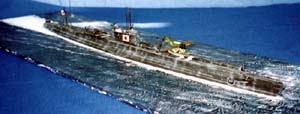 These
same boats were credited with a range of 37,500 miles at 14 knots, a figure
never matched by any other diesel-electric submarine. These large boats
could each carry three float plane bombers, the only submarines in history
so capable. Japan built 41 submarines that could carry one or more aircraft,
while the vast submarine fleets of the United States, Britain, and Germany
included not one submarine so capable.
These
same boats were credited with a range of 37,500 miles at 14 knots, a figure
never matched by any other diesel-electric submarine. These large boats
could each carry three float plane bombers, the only submarines in history
so capable. Japan built 41 submarines that could carry one or more aircraft,
while the vast submarine fleets of the United States, Britain, and Germany
included not one submarine so capable.
During the Second World War, there were 56 submarines larger than 3,000 tons in the entire world, and 52 of these were Japanese. Japan built 65 submarines with ranges exceeding 20,000 miles at ten knots, while the Allies had no submarine capable of this feat. By 1945, Japan had built all 39 of the world's diesel-electric submarines with more than 10,000 horsepower, and all 57 of the world's diesel-electric submarines capable of 23+ knots surface speed.
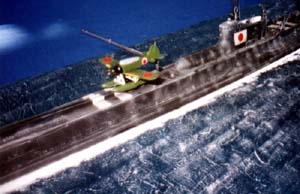 The
Japanese navy also built submarines with the fastest underwater speeds
of any nation's combat submarines. They employed 78 midget submarines
capable of 18.5 to 19 knots submerged, and built 110 others capable of
16 knots. As the war was ending they completed four medium-sized submarines
capable of 19 knots submerged. This exceeds the 17.5-knot performance
of the famed German Type XXI coming into service at the same time. As
early as 1938, Japan completed the experimental Submarine Number 71, capable
of more than 21 knots submerged.
The
Japanese navy also built submarines with the fastest underwater speeds
of any nation's combat submarines. They employed 78 midget submarines
capable of 18.5 to 19 knots submerged, and built 110 others capable of
16 knots. As the war was ending they completed four medium-sized submarines
capable of 19 knots submerged. This exceeds the 17.5-knot performance
of the famed German Type XXI coming into service at the same time. As
early as 1938, Japan completed the experimental Submarine Number 71, capable
of more than 21 knots submerged.
Japanese submarines employed the best torpedoes available during the Second World War. The Type 95 torpedo used pure oxygen to burn kerosene, instead of the compressed air and alcohol used in other nation's torpedoes. This gave them about three times the range of their Allied counterparts, and also reduced their wake, making them harder to notice and avoid. The Type 95 also had by far the largest warhead of any submarine torpedo, initially 893 pounds (405 kg), increased to 1210 pounds (550 kg) late in the war. All Japanese torpedoes made during the war used Japanese Type 97 explosive, a mixture of 60% TNT and 40% hexanitrodiphenylamine. Most importantly, the Type 95 used a simple contact exploder, and was therefore far more reliable than its American counterpart, the Mark 14, until the latter was improved in late-1943. Japan also developed and used an electric torpedo, the Type 92. This weapon had modest performance compared to the Type 95, but emitted no exhaust and, therefore, left no wake to reveal its presence. Similar electric torpedoes were used by several nations.
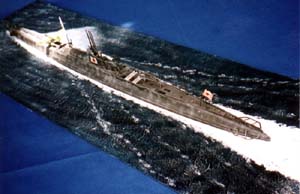 Given
their size, range, speed, and torpedoes, Japanese submarines achieved
surprisingly little. This was because they were mainly employed against
warships, which were fast, maneuverable, and well-defended when compared
to merchant ships. Japanese naval doctrine was built around the concept
of fighting a single decisive battle, as they had done at Tsushima 40
years earlier. They thought of their submarines as scouts, whose main
role was to locate, shadow, and attack Allied naval task forces. This
approach gave a significant return in 1942 when they sank two fleet carriers,
one cruiser, and a few destroyers and other warships, and also damaged
two battleships, one fleet carrier (twice), and a cruiser. However, as
Allied intelligence, technologies, methods, and numbers improved, the
Japanese submarines were never again able to achieve this frequency of
success. For this reason, many argue that the Japanese submarine force
would have been better used against merchant ships, patrolling Allied
shipping lanes instead of lurking outside naval bases. Bagnasco credits
the Japanese submarine fleet with sinking 184 merchant ships of 907,000
GRT. This figure is far less than achieved by the Germans (2,840 ships
of 14.3 million GRT), the Americans (1,079 ships of 4.65 million tons),
and the British (493 ships of 1.52 million tons). It seems reasonable
that an all-out blitz of the American west coast, the Panama Canal, and
the approaches to Hawaii, New Zealand, Australia and India would have
caused the Allies more difficulty than did the naval deprivations that
were actually achieved. Losing a significant number of merchant ships,
and also needing to spread meager defenses even more thinly along two
coasts, would surely have had some substantial consequences for the United
States in 1942.
Given
their size, range, speed, and torpedoes, Japanese submarines achieved
surprisingly little. This was because they were mainly employed against
warships, which were fast, maneuverable, and well-defended when compared
to merchant ships. Japanese naval doctrine was built around the concept
of fighting a single decisive battle, as they had done at Tsushima 40
years earlier. They thought of their submarines as scouts, whose main
role was to locate, shadow, and attack Allied naval task forces. This
approach gave a significant return in 1942 when they sank two fleet carriers,
one cruiser, and a few destroyers and other warships, and also damaged
two battleships, one fleet carrier (twice), and a cruiser. However, as
Allied intelligence, technologies, methods, and numbers improved, the
Japanese submarines were never again able to achieve this frequency of
success. For this reason, many argue that the Japanese submarine force
would have been better used against merchant ships, patrolling Allied
shipping lanes instead of lurking outside naval bases. Bagnasco credits
the Japanese submarine fleet with sinking 184 merchant ships of 907,000
GRT. This figure is far less than achieved by the Germans (2,840 ships
of 14.3 million GRT), the Americans (1,079 ships of 4.65 million tons),
and the British (493 ships of 1.52 million tons). It seems reasonable
that an all-out blitz of the American west coast, the Panama Canal, and
the approaches to Hawaii, New Zealand, Australia and India would have
caused the Allies more difficulty than did the naval deprivations that
were actually achieved. Losing a significant number of merchant ships,
and also needing to spread meager defenses even more thinly along two
coasts, would surely have had some substantial consequences for the United
States in 1942.
The Japanese did, of course, make some attacks on merchant shipping in the Pacific and Indian Oceans, but these were the minority of missions. Frequently, they waited for fleets that were never seen, supported spectacularly brave but inconsequential reconnaissance flights, or toted midget submarines about, all of which achieved rather less than was possible with so valuable a resource as the Japanese submarine fleet. Worse from a naval perspective, Japanese submarines were increasingly employed in running supplies to the starving garrisons of isolated islands. The Japanese expended hundreds of sorties in this way, which might have otherwise been used offensively against the Allied war effort. A submarine's cargo capacity was much less than that of a relatively inexpensive freighter. However, Japan was understandably reluctant to let island garrisons starve. Additionally, many practically unarmed submarines (including 26 built for Army use) were built specifically for the supply role, consuming production resources as well.
 For
their disappointing achievements, Japanese submarines paid heavily. Japan
started the war with 63 ocean-going submarines (i.e., not including midgets),
and completed 111 during the war, for a total of 174. However, three-quarters
of these (128 boats) were lost during the conflict, a proportion of loss
similar that experienced by Germany's U-boats. Most of the surviving boats
were either dedicated to training roles or were recently completed and
never saw combat. Of those which saw significant combat, the toll was
very grim indeed. For example, of the 30 submarines that supported the
Pearl Harbor attack, none survived the war.
For
their disappointing achievements, Japanese submarines paid heavily. Japan
started the war with 63 ocean-going submarines (i.e., not including midgets),
and completed 111 during the war, for a total of 174. However, three-quarters
of these (128 boats) were lost during the conflict, a proportion of loss
similar that experienced by Germany's U-boats. Most of the surviving boats
were either dedicated to training roles or were recently completed and
never saw combat. Of those which saw significant combat, the toll was
very grim indeed. For example, of the 30 submarines that supported the
Pearl Harbor attack, none survived the war.
Compared to German submarines, Japan's huge boats were relatively easy to sight visually and with radar, slow to dive, hard to maneuver underwater, easy to track on sonar, and easy to hit. Japanese hulls were also not as strong as those of German boats, and therefore could not dive as deeply nor survive such rough treatment. Also, they lacked radar until the first sets were installed in June 1944, and never had sets as good as the Allies possessed.
Compounding these deficiencies, Japan was at war with the United States and the United Kingdom, two nations embroiled in a vast conflict with hundreds of U-boats in the Atlantic, and hence two nations which poured lavish resources into anti-submarine warfare (ASW) research and development. As an example of the fruits of this research, in June 1944 the US Navy sank the I-52 by using code-breaking to discover her schedule, finding her at night with radar-equipped carrier-based aircraft, tracking her underwater with sonobuoys dropped by those aircraft, and sinking her with acoustic homing torpedoes dropped by the same aircraft. The Japanese could achieve none of these technological feats at that time.
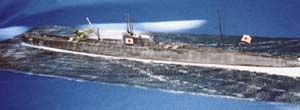 In
the face of such disadvantages, morale declined within the Japanese submarine
force. This is reflected in a post-war report prepared by the US and British
Navies which states, "It was frankly impossible to believe that submarines
could spend weeks on the US west coast 'without contacts,' or spend more
than 40 days running among the Solomons during the Guadalcanal campaign
'without seeing any targets.' Even the Japanese commanding officers could
not disguise their embarrassment when recounting these tales. Further
enlightenment is found in the extremely large number of times the target
was 'too far away to attack.'"
In
the face of such disadvantages, morale declined within the Japanese submarine
force. This is reflected in a post-war report prepared by the US and British
Navies which states, "It was frankly impossible to believe that submarines
could spend weeks on the US west coast 'without contacts,' or spend more
than 40 days running among the Solomons during the Guadalcanal campaign
'without seeing any targets.' Even the Japanese commanding officers could
not disguise their embarrassment when recounting these tales. Further
enlightenment is found in the extremely large number of times the target
was 'too far away to attack.'"
The Type B-1 (I-15 through 39)
This was the most numerous class of Japanese submarines. These boats were fast, long-ranged, and carried a seaplane which could be launched on a forward catapult. However, I-17 carried the catapult aft, and her hangar opened aft as well. During the war, the aircraft facilities were removed from some boats in order to mount a second 14cm gun. In 1944, I-36 and I-37 were modified to carry four Kaiten, and I-36 was later modified again to carry six Kaiten.
 They
were used extensively and had their share of successes. On 31 August 1942,
I-26 damaged the aircraft carrier USS Saratoga with one torpedo hit (out
of six launched), removing her from the Guadalcanal campaign at a critical
time. Two weeks later, on 15 September, I-19 achieved an incredible success
when she fired six torpedoes at aircraft carrier USS Wasp. Two of these
hit the carrier forward and ignited gasoline storage, dooming the ship.
The remaining four torpedoes of this salvo went several thousand yards
further and encountered a second American carrier task force, damaging
the battleship USS North Carolina enough to require two months to repair,
and sinking thedestroyer USS O'Brien. This was among the most damaging
torpedo salvoes in history. On 13 October, it was again the turn of I-26
as she finished off USS Juneau, one of several damaged and unescorted
American cruisers which had survived the First Naval Battle of Guadalcanal
the evening before. The loss of life on USS Juneau was extreme, including
the five Sullivan brothers. Bagnasco credits all of the Type B boats (B1,
B2, and B3 combined) with sinking 56 merchant ships of 372,730 GRT.
They
were used extensively and had their share of successes. On 31 August 1942,
I-26 damaged the aircraft carrier USS Saratoga with one torpedo hit (out
of six launched), removing her from the Guadalcanal campaign at a critical
time. Two weeks later, on 15 September, I-19 achieved an incredible success
when she fired six torpedoes at aircraft carrier USS Wasp. Two of these
hit the carrier forward and ignited gasoline storage, dooming the ship.
The remaining four torpedoes of this salvo went several thousand yards
further and encountered a second American carrier task force, damaging
the battleship USS North Carolina enough to require two months to repair,
and sinking thedestroyer USS O'Brien. This was among the most damaging
torpedo salvoes in history. On 13 October, it was again the turn of I-26
as she finished off USS Juneau, one of several damaged and unescorted
American cruisers which had survived the First Naval Battle of Guadalcanal
the evening before. The loss of life on USS Juneau was extreme, including
the five Sullivan brothers. Bagnasco credits all of the Type B boats (B1,
B2, and B3 combined) with sinking 56 merchant ships of 372,730 GRT.
Of these 20 boats, 95% were lost during the war, and only I-36 survived.
Building the I-19
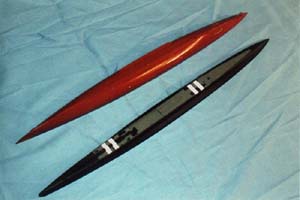 This
kit has been around for a while. The parts are molded in hard gray and
red plastic and extensive metal parts are included. I knew that this kit
came with hardware to make a motorized model. I did not realize how complex
the mechanization actually is. This probably causes the kit to be higher
priced than other Nichimo submarines. Generally the molding is excellent
with little flash and great detail. I built the I-19 OOB with a few basic
techniques to jazz up the build such as weathering and scratching railings.
This
kit has been around for a while. The parts are molded in hard gray and
red plastic and extensive metal parts are included. I knew that this kit
came with hardware to make a motorized model. I did not realize how complex
the mechanization actually is. This probably causes the kit to be higher
priced than other Nichimo submarines. Generally the molding is excellent
with little flash and great detail. I built the I-19 OOB with a few basic
techniques to jazz up the build such as weathering and scratching railings.
The extensive instructions cover two large sheets backed up. There are many detail inserts that provide enough detail for even the most anal of super detailers. They suggest several different paint schemes depending on the year. I chose an all black scheme used on late-war boats because I wanted to experiment with a new weathering technique.
Painting
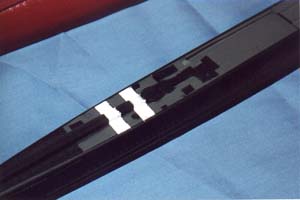 I
spray painted the major colors while the parts were on the sprue. I used
Testors dark gray to paint the decking. I wanted a little variety for
the decking so I masked the deck and then oversprayed flat black for the
upper hull. I sprayed the lower hull dark red. The hull pieces split at
the waterline. Late war boats had suicidal white recognition markings
forward and aft of the con. I masked and applied them as well.
I
spray painted the major colors while the parts were on the sprue. I used
Testors dark gray to paint the decking. I wanted a little variety for
the decking so I masked the deck and then oversprayed flat black for the
upper hull. I sprayed the lower hull dark red. The hull pieces split at
the waterline. Late war boats had suicidal white recognition markings
forward and aft of the con. I masked and applied them as well.
Assembly
Step one in the instructions assembles the extensive lower hull mechanisms. I was not into this, so I skipped most of these steps. It includes assembling the motor mount, reduction gearing, wiring and adding ballast (sand) to the hull. I wonder how this baby would do in the water now. Anyone out there actually put one of these to sea? Next to the assembly instructions was a neat detail reference for the bow of the boat that explained bow plane operation. Instructions for assembling and installing the shafts, screws, and aft hydroplanes came next. Grease boxes make the shafts watertight.
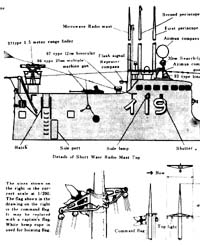 Step
two assembles the bridge. I painted the bridge deck dark gray and the
inside bridge walls white. The kit comes with periscopes and aerials in
the fully raised position. Next I added the myriad of bridge parts and
fixtures. These included various metal aerial, plastic binoculars, anti
aircraft gun and range finder for the main gun. Two excellent bridge detail
drawings really spurred me on to add details. Rung ladders are molded
in to the bridge side detail. Bent wire rungs and rails would really add
to the appearance. Next I assembled the 140 mm main gun – a switch
mounted under the deck allows the gun to act as a power switch for the
electric motor. I then added the various deck cranes to the after deck.
Step two wraps up with building the boat's aircraft. This required a bit
of cleanup as there were ejector marks and sinkholes. Still, the parts
built up to a reasonable representation of the Yokosuka E1AY (Glen) float
plane. I painted the underside of the bird light gray and the topside
IJN Green. The canopy was finished with light gray.
Step
two assembles the bridge. I painted the bridge deck dark gray and the
inside bridge walls white. The kit comes with periscopes and aerials in
the fully raised position. Next I added the myriad of bridge parts and
fixtures. These included various metal aerial, plastic binoculars, anti
aircraft gun and range finder for the main gun. Two excellent bridge detail
drawings really spurred me on to add details. Rung ladders are molded
in to the bridge side detail. Bent wire rungs and rails would really add
to the appearance. Next I assembled the 140 mm main gun – a switch
mounted under the deck allows the gun to act as a power switch for the
electric motor. I then added the various deck cranes to the after deck.
Step two wraps up with building the boat's aircraft. This required a bit
of cleanup as there were ejector marks and sinkholes. Still, the parts
built up to a reasonable representation of the Yokosuka E1AY (Glen) float
plane. I painted the underside of the bird light gray and the topside
IJN Green. The canopy was finished with light gray.
Step three assembles the upper hull components. A drum assembly ensures that the forward metal hydroplanes install correctly and can be posed. Instruction for sealing the upper and lower hull parts together follow. I next added the forward diving planes and guards. (both metal) Instructions say to fix the bird and mount to the catapult at this point but I waited until later for this. I next added the aircraft crane, erected to service the plane. I then wrapped up assembly by adding aft details such as the large radio mast, guard rope stays and aft hydroplanes and guards. The kit comes with no deck railing so I scratched that bit of detail using brass wire.
Weathering
Next, I lightly drybrushed all surfaces with light gray to bring out the excellent molded in detail. I often use pastels to weather my models but this has always been using dark colors on light surfaces. This beast was flat black! Hey why not use white pastel for the same effect. I used a fine brush to apply a white wash to simulate wear and salt deposits all over the boat. I wrapped up the model by adding aft lines and detailing the cranes with .006 brass wire painted flat black.
Decals
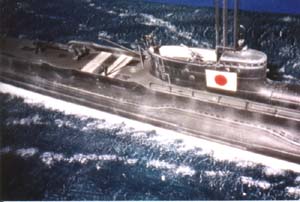 The
Nichimo decals are the most unusual I have ever seen. They are reverse
to the ordinary. You look at the decal sheet and all you see is adhesive.
The decal detail is next to the decal paper. You apply them like a dry
transfer. First I cut them out as best I could. Care should be used because
it is hard to see the decal edge. I then pressed the decal in place with
the paper side out. Then I wet the decal paper and rubbed the decal in
place. Lift the paper and the decal is set permanently. You cannot move
these decals once applied. I put a Hinomaru on either side of the conning
tower. Try as I might, I still messed up on the alignment here. Oh well,
so much for a show entry on this one. The markings I used reflect more
of an I-29 than an I-19. I then applied decals to the aircraft. Once in
place these decals are beautiful and the thinnest I have ever seen. I
bent the ensign decal around a strip of aluminum foil and affixed it.
I cut it out and placed it on the aft mast for some color.
The
Nichimo decals are the most unusual I have ever seen. They are reverse
to the ordinary. You look at the decal sheet and all you see is adhesive.
The decal detail is next to the decal paper. You apply them like a dry
transfer. First I cut them out as best I could. Care should be used because
it is hard to see the decal edge. I then pressed the decal in place with
the paper side out. Then I wet the decal paper and rubbed the decal in
place. Lift the paper and the decal is set permanently. You cannot move
these decals once applied. I put a Hinomaru on either side of the conning
tower. Try as I might, I still messed up on the alignment here. Oh well,
so much for a show entry on this one. The markings I used reflect more
of an I-29 than an I-19. I then applied decals to the aircraft. Once in
place these decals are beautiful and the thinnest I have ever seen. I
bent the ensign decal around a strip of aluminum foil and affixed it.
I cut it out and placed it on the aft mast for some color.
Putting I-19 at Sea
I am reasonably happy with the way the kit turned out. I thought this boat just had to have some water! I cut out a large rectangle of foam board to form the base. I placed the model on the board and drew an outline around the hull. I then painted the entire surface with Ceramcoat acrylic royal blue and green. I used Liquitex acrylic gloss heavy gel medium and a large brush to form a pattern of waves across my "ocean." I built up bow waves with several applications of the medium. Stipple the medium with a firm brush tip to rough up the wake behind the ship.
After drying overnight, the gel had a nice clear gloss finish to it. I thought about going over the surface with Future but it really was not necessary. I painted in the bow waves and wake with Ceramcoat white. Switch between thinned down blues and white to blend in things a tad. I then drybrushed the ocean lightly. Once dry I tacked the model in place with good old RC Z 56 and took it out for some photographs.
Conclusion
I recommend this kit to large scale ship lovers of average experience. It build up to an impressive boat. More experienced modelers could go to town detailing and scratching parts on this one. I still like the idea of making this kit motorized as designed. Oh well, maybe some day! I'm just about ready to tackle one of Nichimo's Uboats now!
Sources
-
Polmar, Norman and Dorr B. Carpenter. Submarines of the Imperial Japanese Navy, Conway Maritime Press, 1986.
-
Boyd, Carl and Akihiko Yoshida. The Japanese Submarine Force and World War II, Naval Institute Press, 1995.
-
See the excellent Imperial Japanese Navy web site
EDITOR'S NOTE: Richard's model of the I-19 won first prize in its category at the recent IPMS/Austin contest. Congratulations Richard




